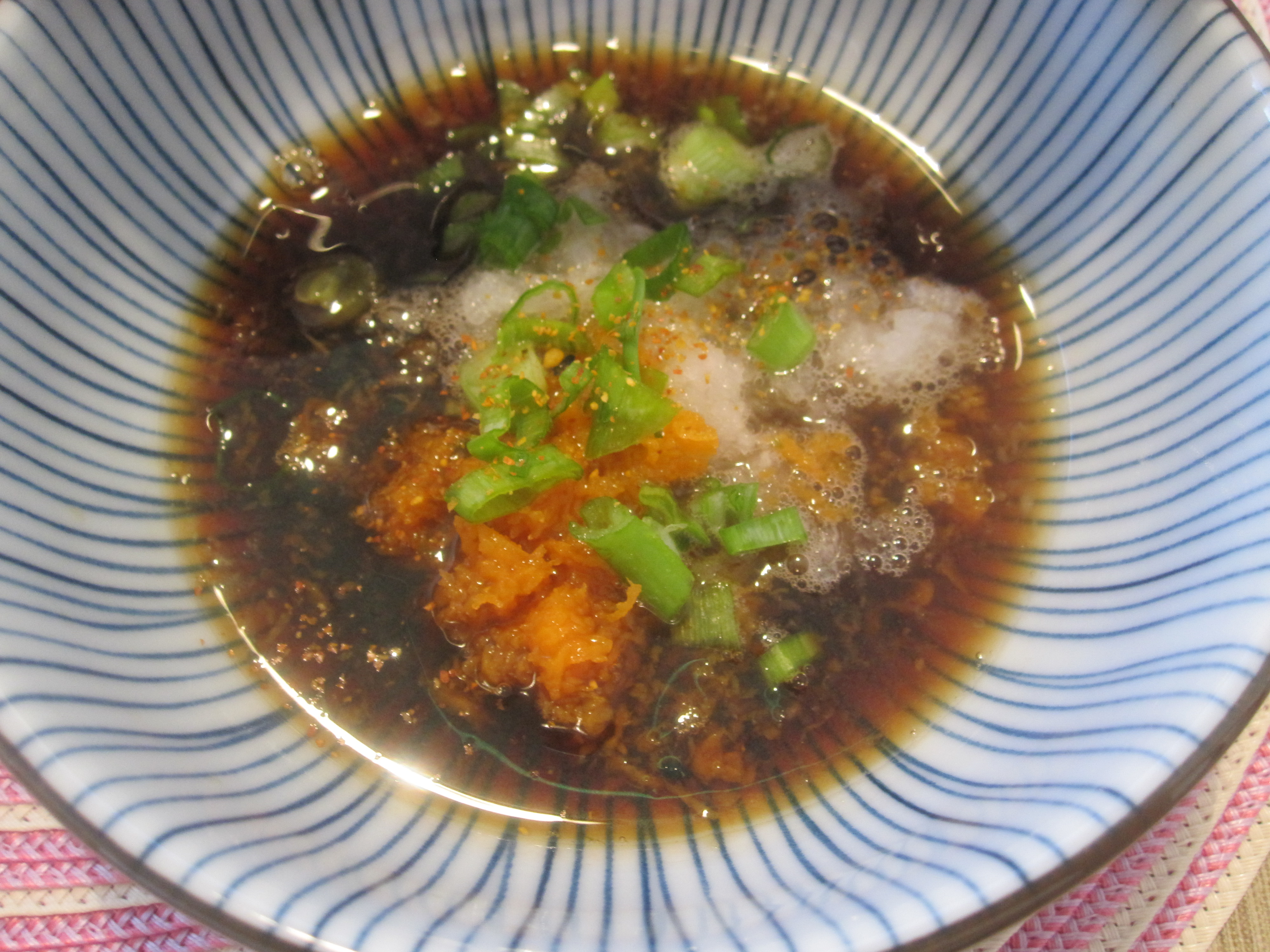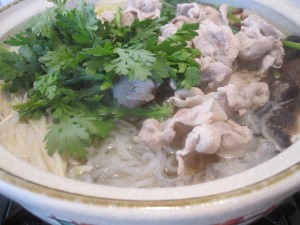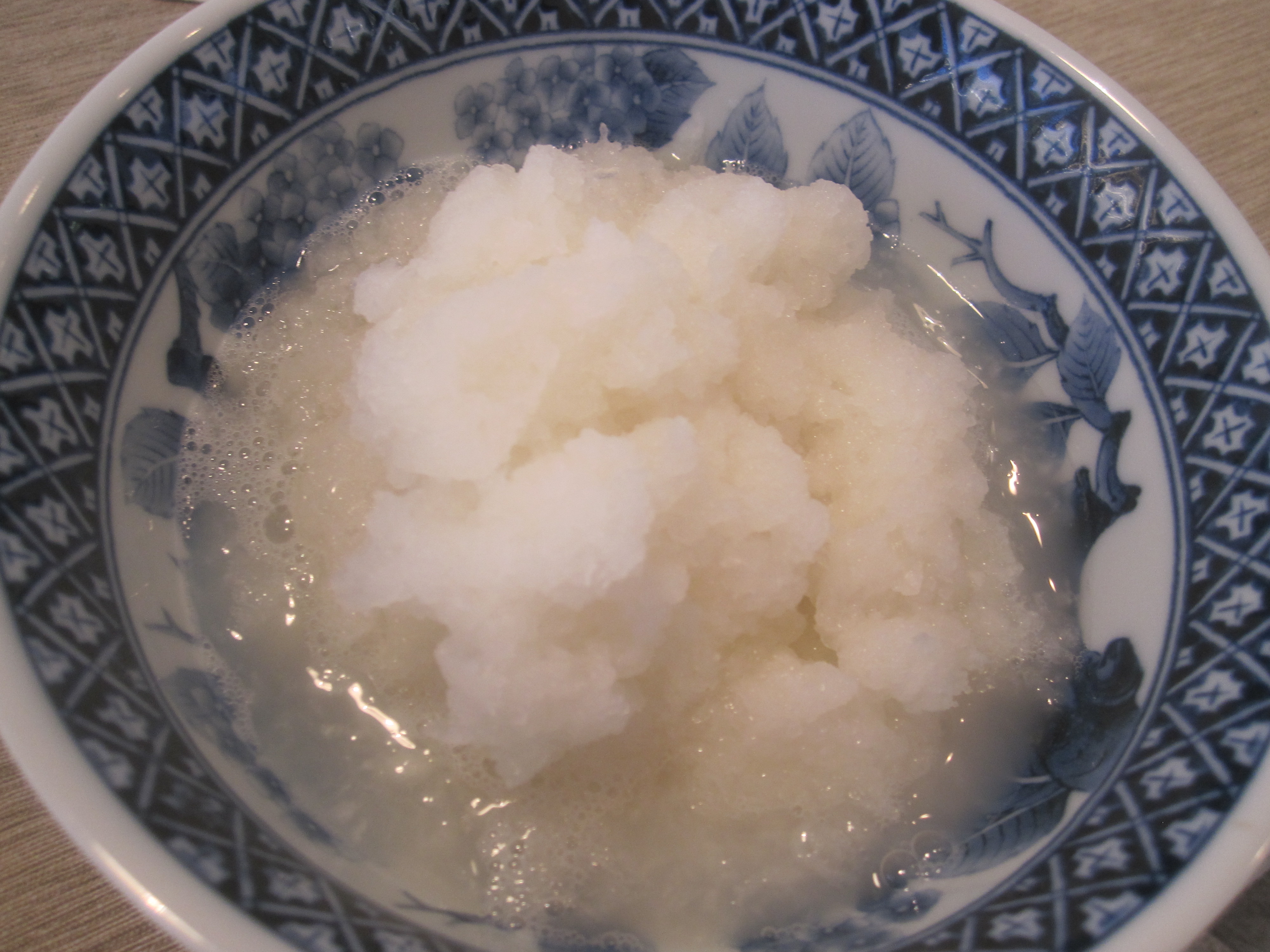Buta Shabu-Shabu (Japanese Hot Pot with Pork)
Dreary, cold, June Gloom isn’t so bad when I know we’re having shabu-shabu for dinner. I’m sure there are many of you reading this that are thinking, “What? Shabu-shabu in the summer?” Trust me, it worked really well for us in Southern California last week while my mom was visiting.
I woke up one morning to very gray skies and cool weather. I decided right then that we would have shabu-shabu for dinner that night. It was only a few months ago that I resigned to Spring’s arrival and the fact that our nabe would remain in storage until Fall because it would be too warm for shabu-shabu which is typically eaten during the colder months of Autumn and Winter. I’m so glad that I was wrong! Although the sun eventually came out the day we ate shabu-shabu, the evening was cool and it was the perfect dinner for June Gloom.
Shabu-shabu is Japanese hot-pot where meat and vegetables are cooked in a simple broth. My mom always made our shabu-shabu broth using water and konbu dashi, and that’s how I prepare our shabu-shabu too. The meat that is typically used for shabu-shabu is very thinly sliced beef. At the Asian supermarket you will find a variety of different cuts of beef for shabu-shabu; however, I typically buy rib-eye shabu-shabu from my favorite neighborhood supermarket in West Los Angeles because they’ve got the thinnest meat that I’ve come across in the L.A./O.C. area. The thinner the meat, the more tender and superb your shabu-shabu will be.
Our family refers to pork shabu-shabu as buta-shabu. “Buta” means pig or pork in Japanese, and “shabu”, is short for shabu-shabu which is descriptive of the swishing cooking sound that the meat or vegetable makes when swished-around with chopsticks in the hot broth of the nabe: shabu-shabu… shabu-shabu!
I can’t resist but to include this little tidbit since I mentioned “buta”. While my mom was staying with us, Bebe E regularly made what my mom calls, her buta kao. This literally translates in English to “pig face”. Now, that might sound very derogatory, but in all honesty we say this with utmost love and affection. Whenever Bebe E is tired, unhappy about one thing or another, and worse, when I scold her for touching things she shouldn’t be, she responds by showing her displeasure by scrunching her lips out in a very upset, fishy-duckbill-like unattractive way, and then makes motorboat sounds. I have a picture of her making this face but I don’t want to share that publicly since one day she’ll be old enough to read my blog and might be upset that I freely posted this on the World Wide Web.
Alright, let’s get back to our shabu-shabu chat. Growing up, my mom used either beef, pork, chicken or seafood for our shabu-shabu. When I make shabu-shabu for Bebe Dada and Big Onechan, I usually use beef and only once in a while add chicken or seafood, but I rarely ever use pork. However, our close family friends, the Kimuras, make buta-shabu with only three ingredients: pork, spinach, and tofu and for some reason I had a craving for this that gloomy June morning. With my mom’s help we made the following shabu-shabu by incorporating some of our standard shabu ingredients to the Kimura’s pork-spinach-tofu-shabu.
Buta-Shabu (Pork Shabu-Shabu)
- 2 packages of pork shabu-shabu meat
- 1 bunch of spinach
- 1/4 nappa cabbage, rough chopped
- 1 block of soft tofu, cubed
- 1 package ito-konyaku noodles
- Shiitake mushrooms, sliced in half
- Enoki mushrooms, ends removed
- Shungiku
- 1 piece konbu dashi
- Water
- Bottled ponzu sauce
garnish for ponzu dipping sauce:
- 3 grated carrots
- 1/2 grated Japanese daikon
- 3 stalks green onions, chopped
1) Pour water into nabe about 1/2 to 3/4 of the way full. Add a piece (or two) of konbu dashi to the water and allow it to soak. After you’ve prepared all of the ingredients, simmer water on medium heat.
2) Grate daikon and carrots separately and place each in serving bowls.
 Big Onechan is usually my happy daikon grater but she wasn’t here to help so I had to flex my muscles to get this done. She doesn’t actually use the grated daikon in her ponzu sauce, but she finds the act of grating daikon “fun”.
Big Onechan is usually my happy daikon grater but she wasn’t here to help so I had to flex my muscles to get this done. She doesn’t actually use the grated daikon in her ponzu sauce, but she finds the act of grating daikon “fun”.
3) Remove stalks from shiitake and slice. Cut bottom of enoki mushrooms. Rinse ito-konyaku and cut noodles into shorter 6-inch pieces. Cube tofu, chop cabbage. Trim spinach if you like. We like to buy Japanese or Korean spinach with the pink roots attached. We trim off the stringy roots but save the pink portion of the root because this part tastes pretty good when prepared shabu-shabu style. Set aside.
4) Once the water in the nabe is hot enough, add pork one slice at a time. Once it is cooked, remove pork from the nabe and set aside in a dish. Skim all of the fat and residue from the nabe so that your broth is clear of debris.
5) Add tofu, cabbage, konyaku, nappa, and mushrooms. Allow this to cook for about 4 minutes. Add in the spinach, shungiku and cooked pork. Transfer the nabe to a portable tabletop stove and dig in!
Enjoy shabu-shabu by dipping the pork and vegetables into a ponzu dipping sauce garnished with grated carrots, daikon and green onions. Add a dash of togarashi for a little spice. This takes shabu-shabu to a new level of flavor.

I’m fairly certain that this will be our last shabu-shabu dinner until Fall, but look-out for new shabu-shabu posts once our Southern California weather turns cold in October / November. It’s one of our favorite winter dishes and I make this often because it’s so easy to prepare!
Thank you, Mom, for staying with us and keeping us company, as well as for taking care of Bebe E, all the laundry you helped with AND for a great buta-shabu dinner.
Jya-matta-ne! (See ya next time!)
Judy | bebe mama
- 2 packages of pork shabu-shabu meat
- 1 bunch of spinach
- ¼ nappa cabbage, rough chopped
- 1 block of soft tofu, cubed
- 1 package ito-konyaku noodles
- Shiitake mushrooms, sliced in half
- Enoki mushrooms, ends removed
- Shungiku
- 1 piece konbu dashi
- Water
- Bottled ponzu sauce
- garnish for ponzu dipping sauce:
- 3 grated carrots
- ½ grated Japanese daikon
- 3 stalks green onions, chopped
- Pour water into nabe about ½ to ¾ of the way full. Add a piece (or two) of konbu dashi to the water and allow it to soak. After you've prepared all of the ingredients, simmer water on medium heat.
- Grate daikon and carrots separately and place each in serving bowls.
- ) Remove stalks from shiitake and slice. Cut bottom of enoki mushrooms. Rinse ito-konyaku and cut noodles into shorter 6-inch pieces. Cube tofu, chop cabbage. Trim spinach if you like. We like to buy Japanese or Korean spinach with the pink roots attached. We trim off the stringy roots but save the pink portion of the root because this part tastes pretty good when prepared shabu-shabu style. Set aside.
- Once the water in the nabe is hot enough, add pork one slice at a time. Once it is cooked, remove pork from the nabe and set aside in a dish. Skim all of the fat and residue from the nabe so that your broth is clear of debris.
- Add tofu, cabbage, konyaku, nappa, and mushrooms. Allow this to cook for about 4 minutes. Add in the spinach, shungiku and cooked pork. Transfer the nabe (pot) to a portable tabletop stove and dig in!







22 Comments